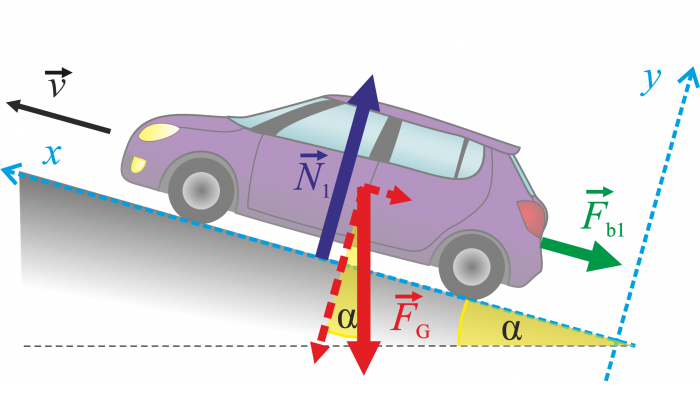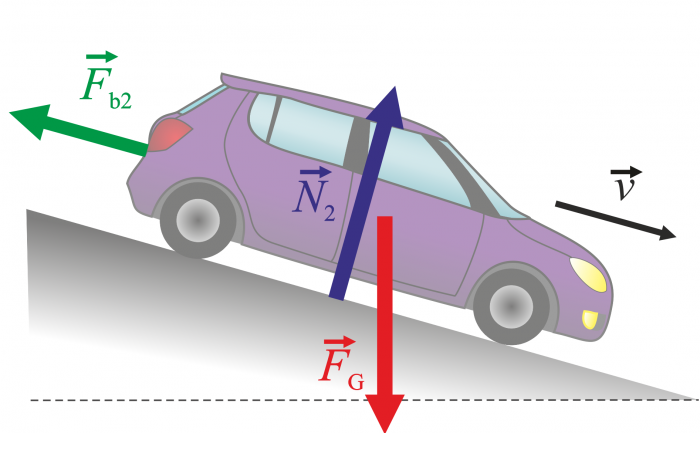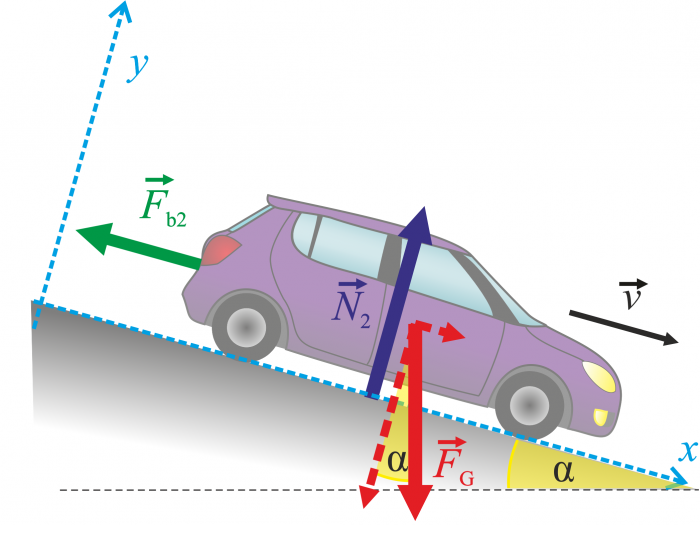Braking Vehicle
Task number: 1984
When the brake pedal of a car moving 80 km·h-1 on a straight asphalt road is fully pressed, the car can stop in 50 m. How long will its braking distance be on an identical road which forms a 5° angle with the horizontal plane? Consider both the case when it brakes downhill and when it brakes uphill. Assume that at the time t = 0 s the coordinate is x = 0 m. The wheels do not slip. Neglect the air resistance.

Analysis
First we will use the given information to find out what braking force acts upon the car while braking on a horizontal surface. If the wheels do not slip, the braking force is realised through the rolling resistance of the wheels (for which holds \(F_r\,=\,\xi\frac{N_\mathrm{w}}{R}\), R is the radius of the wheels, ξ is the rolling resistance coefficient, Nw is the force with which the wheel acts upon the road) and the static friction of the wheels against the road (the velocity of the wheel in relation to the road is zero at the point of contact). We will assume that when the brake pedal is pressed, the car is on the edge of a skid and the maximum static frictional force \(F_\mathrm{f}\,=\,fN\) will be realized. We will neglect the rolling resistance (the value of ξ for asphalt and rubber is equal to 0.0016 m and the value of f is equal to 0.55). Then we need to think about how the braking force will change while braking downhill and uphill.
Given values
v0 = 80 km·h−1 velocity of the car s1 = 50 m braking distance for the car moving on a horizontal surface α = 5° angle between the road and the horizontal plane sb1 = ? m braking distance of the car moving uphill sb2 = ? m braking distance of the car moving downhill Hint 1 – Braking on a horizontal surface – Acceleration of the car
Draw a picture and mark the forces acting upon the car. Write the equation of motion for it. Express the acceleration of the car from this equation.
Hint 2 – Braking on a horizontal surface – Braking force
You know the acceleration of the car. Express how its velocity and its coordinates change with time. Find the time and distance of stopping.
Note
We can also use conservation of energy to express the braking force. The kinetic energy of a car at the beginning of its braking is equal to the work done by the braking force on the braking distance:
\[W\,=\,E_k\,,\] \[F_\mathrm{b}s_\mathrm{s}\,=\,\frac{mv_0^2}{2}.\]Therefore:
\[F_\mathrm{b}=\frac{mv_0^2}{2s_\mathrm{s}}\,.\]Hint 3 – Braking force on a horizontal surface and on a slope
The braking force is realized through the maximal static friction between the wheels and the road. What does frictional force depend on? Does its magnitude differ when braking on a horizontal surface or on a slope?
Hint 4 – Braking uphill – Equations of motion
Realise which forces act upon a car moving uphill. Draw a free body diagram and mark these forces into it. Write the equation of motion of the car and rewrite it using scalars.
Hint 5 – Braking force on a slope
On a slope, just as on a horizontal surface, braking force is realized through static friction between the wheels and the road . Express the frictional force for the case when the car moves uphill. Use f from relation (12) to express it.
Hint 6 – Evaluating acceleration, calculating total distance
Express the acceleration of the car from the equation of motion (13). Similarly to the case of the car moving on a horizontal surface, express the braking distance of the car.
Hint 7 – Braking downhill – Equations of motion
Realise what forces act upon a car moving downhill. Draw a free body diagram and mark the forces in it. Write the equation of motion for the car and rewrite it using scalars.
Hint 8 – Braking force on a slope
On a slope, just as on a horizontal surface, braking force is realized through static friction between the wheels and the road. Express the frictional force for the case of the car moving downhill. Use f from relation (12) to express it.
Hint 9 – Evaluating acceleration, calculating total distance
Evaluate the acceleration of the car from the equation of motion (13). Similarly to the case of the car moving on a horizontal surface, evaluate the braking distance of the car.
OVERALL SOLUTION
Braking on a horizontal surface
Forces acting upon the car:
\(\vec{F}_\mathrm{{G}}\)…gravitational force
\(\vec{N}\)…normal force with which the road acts upon the car (the force \(\vec{N}\) denotes the net force of the forces acting upon all the wheels)
\(\vec{F}_{\mathrm{b}}\)…braking force
Equation of motion:
\[\vec{F}_{\mathrm{b}}+\vec{F}_{\mathrm{G}}+\vec{N}\,=\, m\vec{a}\,.\]We rewrite the equation using scalars and choose a coordinate system where the x axis is parallel to the car movement. The y axis is perpendicular to the x axis.
\[x:\qquad -F_\mathrm{b}\,=\,ma,\tag{1}\] \[y:\qquad N-F_\mathrm{G}\,=\,0.\tag{2}\]We express the acceleration of the car from equation (1):
\[a\,=\,-\frac{F_\mathrm{b}}{m}\,.\tag{3}\]Calculation of v(t) and s(t):
By integrating relation (3) we get the dependency of the velocity of the car on time:
\[v(t)\,=\,\int{a(t)}\,\mathrm{d}t\,,\] \[v(t)\,=\,\int{\left(-\frac{F_\mathrm{b}}{m}\right)}\,\mathrm{d}t,\] \[v(t)\,=\,-\frac{F_\mathrm{b}}{m}t\,+\,K.\tag{4}\]K is a constant we can determine from the initial conditions:
At time t = 0 s the velocity was v = v0. If we substitute t = 0 s into relation (4), then it must hold that:
v0 = 0 + K.
And therefore:
v0 = K.
If we rewrite equation (4), we get the dependency of the speed of the car on time:
\[v(t)\,=\,-{\frac{F_{\mathrm{b}}}{m}}t\,+\,v_0\,.\tag{5}\]By integrating relation (5) we get the dependency of the coordinate on time:
\[x(t)\,=\,\int{v(t)}\,\mathrm{d}t\,,\] \[x(t)\,=\,\int{\left(-\frac{F_\mathrm{b}}{m}t\,+\,v_0\right)}\,\mathrm{d}t,\] \[x(t)\,=\,-\frac{F_\mathrm{b}}{2m}t^2\,+\,v_0t\,+\,C.\tag{6}\]C is a constant that we can determine from the initial conditions:
At time t = 0 s the coordinate is x = 0. If we substitute t = 0 s into relation (6), then it must hold that:
C = 0.
If we rewrite equation (4), we get the dependency of the coordinate of the car on time:
\[x(t)\,=\,-{\frac{F_{\mathrm{b}}}{2m}}t^2\,+\,v_0t\,.\tag{7}\]Calculation of the time and distance of stopping:
At the moment of stopping the velocity of the car is zero. We calculate the time of stopping ts by substituting zero for velocity into relation (5):
\[0\,=\,-{\frac{F_\mathrm{b}}{m}}t_\mathrm{s}\,+\,v_0\,,\] \[t_\mathrm{s}\,=\,\frac{mv_0}{F_\mathrm{b}}.\tag{8}\]We calculate the distance of stopping ss by substituting the time of stopping ts into relation (7):
\[s_\mathrm{s}\,=\,-{\frac{F_{\mathrm{b}}}{2m}}t_\mathrm{s}^2\,+\,v_0t_\mathrm{s}\,,\] \[s_\mathrm{s}\,=\,-{\frac{F_{\mathrm{b}}}{2m}}\left(\frac{mv_0}{F_\mathrm{b}}\right)^2\,+\,v_0\frac{mv_0}{F_\mathrm{b}},\] \[s_\mathrm{s}\,=\,-\frac{mv_0^2}{2F_\mathrm{b}}\,+\,\frac{mv_0^2}{F_\mathrm{b}},\] \[s_\mathrm{s}\,=\,\frac{mv_0^2}{2F_\mathrm{b}}.\tag{9}\]We express the braking force from relation (9):
\[F_\mathrm{b}\,=\,\frac{mv_0^2}{2s_\mathrm{s}}\,.\tag{10}\]Note:
We can also use conservation of energy to express the braking force. The kinetic energy of a car at the beginning of its braking is equal to the work done by the braking force on the braking distance:
\[W\,=\,E_k\,,\] \[F_\mathrm{b}s_\mathrm{s}\,=\,\frac{mv_0^2}{2}.\]Therefore:
\[F_\mathrm{b}=\frac{mv_0^2}{2s_\mathrm{s}}\,.\]Frictional (braking) force is described with the relation:
\[F_\mathrm{b}\,=\,fN,\]f…coefficient of static friction
N…force with which the car acts upon the road
We can see that frictional force depends on the perpendicular force N acting between the wheels and the road. This force will be different on a horizontal surface and on a slope..
On a horizontal surface it holds that:
\[F_\mathrm{b}\,=\,fN\,=\,fmg\,.\tag{11}\]The coefficient of friction f will be the same in both scenarios. We express it from equation (11):
\[f\,=\,\frac{F_\mathrm{b}}{mg}\,.\]We substitute for Fb from relation (10):
\[f\,=\,\frac{v_0^2}{2gs_\mathrm{s}}\,.\tag{12}\]Braking uphill
Forces acting upon a car moving uphill:
\(\vec{F}_{\mathrm{G}}\)…gravitational force
\(\vec{N}_1\)…normal force with which the road acts upon the car
\(\vec{F}_\mathrm{{b_1}}\)…braking force
Equation of motion for a car going uphill:
\[\vec{F}_\mathrm{{b_1}}+\vec{F}_{\mathrm{G}}+\vec{N}_1\,=\, m\vec a_1.\]We rewrite the equation using scalars and choose a coordinate system such that the x axis is parallel to the movement of the car. The y axis is perpendicular to the x axis. We split the gravitational force into two components in the directions of the axes:
\[F_\mathrm{{G_x}}\,=\,F_\mathrm{G}\sin\alpha,\] \[F_\mathrm{{G_y}}\,=\,F_\mathrm{G}\cos\alpha.\]Equation of motion using scalars:
\[x:\qquad -F_\mathrm{{b_1}}-F_\mathrm{G}\sin\alpha\,=\, ma_1,\tag{13}\] \[y:\qquad N_1-F_\mathrm{G}\cos\alpha\,=\,0.\tag{14}\]On a slope it holds that:
\[F_\mathrm{{b_1}}\,=\,fN_1\,.\]We express force N1 from relation (14) and substitute for it:
\[F_\mathrm{{b_1}}\,=\,fF_\mathrm{G}\cos\alpha\,.\]We substitute for f from relation (12):
\[F_\mathrm{{b_1}}\,=\,\frac{v_0^2}{2gs_\mathrm{s}}mg\cos\alpha\,=\, \frac{v_0^2m\cos\alpha}{2s_\mathrm{s}}\,.\tag{15}\]We evaluate acceleration from equation (13):
\[-F_\mathrm{{b_1}}-mg\sin\alpha\,=\, ma_1\,,\] \[-\frac{F_\mathrm{{b_1}}}{m}-g\sin\alpha\,=\, a_1.\tag{16}\]Calculation of distance travelled by the car moving uphill:
By integrating acceleration we obtain the dependency of velocity on time:
\[v_1(t)\,=\,\int{a_1(t)}\,\mathrm{d}t\,,\] \[v_1(t)\,=\,\int{\left(-\frac{F_\mathrm{{b_1}}}{m}-g\sin\alpha\right)}\mathrm{d}t,\] \[v_1(t)\,=\,-\frac{F_\mathrm{{b_1}}}{m}t-gt\sin\alpha+K.\tag{17}\]K is a constant that we can determine from the initial conditions:
At time t = 0 s the velocity was v = v0. If we substitute t = 0 s into relation (17), then it must hold that:
v0 = 0 + K.
And therefore:
v0 = K.
If we rewrite equation (17), we obtain the dependency of the velocity of the car velocity on time:
\[v_1(t)\,=\,-\frac{F_\mathrm{{b_1}}}{m}t-gt\sin\alpha+v_0\,.\tag{18}\]By integrating relation (18) we obtain the dependency of the coordinate on time:
\[x_1(t)\,=\,\int{v_1(t)}\,\mathrm{d}t\,,\] \[x_1(t)\,=\,\int{\left(-\frac{F_\mathrm{{b_1}}}{m}t-gt\sin\alpha+v_0\right)}\,\mathrm{d}t,\] \[x_1(t)\,=\,-\frac{F_\mathrm{{b_1}}}{2m}t^2-\frac{gt^2}{2}\sin\alpha+v_0t+C.\tag{19}\]C is a constant that we can determine from the initial conditions:
At time t = 0 s the coordinate is x = 0. If we substitute t = 0 s into relation (19), then it must hold that:
C = 0.
If we rewrite equation (19), we obtain the dependency of the coordinate of the car on time:
\[x_1(t)\,=\,-\frac{F_\mathrm{{b_1}}}{2m}t^2-\frac{gt^2}{2}\sin\alpha+v_0t\,.\tag{20}\]We calculate the time of stopping ts1 by substituting zero for velocity into relation (18):
\[0\,=\,-\frac{F_\mathrm{{b_1}}}{m}t_\mathrm{{s_1}}-gt_\mathrm{{s_1}}\sin\alpha+v_0\,,\] \[v_0\,=\,t_\mathrm{{s_1}}\left(\frac{F_\mathrm{{b_1}}}{m}+g\sin\alpha\right),\]\[t_\mathrm{{s_1}}\,=\,\frac{v_0}{\frac{F_\mathrm{{b_1}}}{m}+g\sin\alpha}.\tag{21}\]
We substitute the time ts1 into relation (20) and calculate the total distance ss1 travelled by the car:
\[s_\mathrm{{s_1}}\,=-\frac{F_\mathrm{{b_1}}}{2m}{t_\mathrm{s_1}}^2- \frac{g{t_\mathrm{{s_1}}}^2}{2}\sin\alpha+v_0 t_\mathrm{{s_{1}}},\] \[s_\mathrm{{s_1}}\,=\,-\frac{F_\mathrm{{b_1}}}{2m}(\frac{v_0}{\frac{F_\mathrm{{b_1}}}{m}+g\sin\alpha})^2 -\frac{g\left(\frac{v_0}{\frac{F_\mathrm{{b_1}}}{m}+g\sin\alpha}\right)^2}{2}\sin\alpha +v_0\frac{v_0}{\frac{F_\mathrm{{b_1}}}{m}+g\sin\alpha},\] \[s_\mathrm{{s_1}}\,=\,-\frac{\frac{F_\mathrm{{b_1}}}{m}v_0^2}{2\left(\frac{F_\mathrm{b_1}}{m}+g\sin\alpha\right)^2} -\frac{gv_0^2\sin\alpha}{2\left(\frac{F_\mathrm{{b_1}}}{m}+g\sin\alpha\right)^2} +\frac{v_0^2}{\frac{F_\mathrm{{b_1}}}{m}+g\sin\alpha},\] \[s_\mathrm{{s_1}}\,=\,-\frac{v_0^2\left(\frac{F_\mathrm{{b_1}}}{m}+g\sin\alpha\right)}{2\left(\frac{F_\mathrm{{b_1}}}{m}+g\sin\alpha\right)^2} +\frac{v_0^2}{\frac{F_\mathrm{{b_1}}}{m}+g\sin\alpha},\] \[s_\mathrm{{s_1}}\,=\,-\frac{v_0^2}{2\left(\frac{F_\mathrm{{b_1}}}{m}+g\sin\alpha\right)} +\frac{v_0^2}{\frac{F_\mathrm{{b_1}}}{m}+g\sin\alpha} \,=\,\frac{v_0^2}{2\left(\frac{F_\mathrm{{b_1}}}{m}+g\sin\alpha\right)},\]We substitute for Fb1 into relation (15):
\[s_\mathrm{{s_1}}\,=\,\frac{v_0^2} {2\left(\frac{\frac{v_0^2m\cos\alpha}{2s_\mathrm{s}}}{m}+g\sin\alpha\right)} \,=\,\frac{v_0^2}{2\left(\frac{v_0^2\cos\alpha}{2s_\mathrm{s}}+g\sin\alpha\right)}\,,\] \[s_\mathrm{{s_1}}\,=\,\frac{s_\mathrm{s}v_0^2}{v_0^2\cos\alpha+2s_\mathrm{s}g\sin\alpha}.\tag{22}\]We substitute numerically into relation (22):
\[s_\mathrm{{s_1}}\,=\,\frac{50\left(\frac{80}{3.6}\right)^2}{\left(\frac{80}{3.6}\right)^2 \cos{5^{\circ}}\,+\,2\,\cdot50\,\cdot9.81\sin 5^{\circ}}\,\mathrm{m}\,,\] \[s_\mathrm{{s_1}}\,=\,\frac{50\,\cdot22.22^2}{22.22^2\cdot\,0.997\, +\,981\,\cdot\,0.087}\,\mathrm{m},\] \[s_\mathrm{{s_1}}\,=\,\frac{50\,\cdot\,493.72}{493.72\,\cdot\,0.997\,+\,85.35}\,\mathrm{m}\,=\, \frac{24\,612}{492.24\,+\,85.35}\,\mathrm{m}, \] \[s_\mathrm{{s_1}}\,=\,\frac{24\,612}{577.59}\,\mathrm{m}\,=\,42.61\,\mathrm{m}\,\dot=\,42.6\,\mathrm{m}.\]Braking downhill
Forces acting upon a car moving downhill:
\(\vec{F}_{\mathrm{G}}\)…gravitational force
\(\vec{N}_2\)…normal force with which the road acts upon the car
\(\vec{F}_\mathrm{{b_2}}\)…braking force
Equation of motion for a car going downhill:
\[\vec{F}_\mathrm{{b_2}}+\vec{F}_{\mathrm{G}}+\vec{N}_2\,=\, m\vec a_2.\]We rewrite the equation using scalars and choose a coordinate system such that the x axis is parallel to the movement of the car. The y axis is perpendicular to the x axis. We split the gravitational force into two components in the directions of the axes:
\[F_\mathrm{{G_x}}\,=\,F_\mathrm{G}\sin\alpha,\] \[F_\mathrm{{G_y}}\,=\,F_\mathrm{G}\cos\alpha.\]Equation of motion using scalars:
\[x:\qquad -F_\mathrm{{b_2}}+F_\mathrm{G}\sin\alpha\,=\, ma_2,\tag{13}\] \[y:\qquad N_2-F_\mathrm{G}\cos\alpha\,=\,0.\tag{14}\]On a slope it holds that:
\[F_\mathrm{{b_2}}\,=\,fN_2\,.\]We express force N2 from relation (24) and substitute for it:
\[F_\mathrm{{b_2}}\,=\,fF_\mathrm{G}\cos\alpha\,.\]We substitute for f from relation (12):
\[F_\mathrm{{b_2}}\,=\,\frac{v_0^2}{2gs_\mathrm{s}}mg\cos\alpha\,=\, \frac{v_0^2m\cos\alpha}{2s_\mathrm{s}}\,.\tag{25}\]Note: The relations (15) and (25) are identical. Frictional force downhill and uphill on the same slope is the same.
We evaluate the acceleration from equation (23):
\[-F_\mathrm{b_2}+mg\sin\alpha\,=\, ma_2,\] \[-\frac{F_\mathrm{b_2}}{m}+g\sin\alpha\,=\, a_2.\tag{26}\]Calculation of the distance travelled by a car moving downhill:
By integrating acceleration we obtain the dependency of velocity on time:
\[v_2(t)\,=\,\int{a_2(t)}\,\mathrm{d}t\,,\] \[v_2(t)\,=\,\int{\left(-\frac{F_\mathrm{b_2}}{m}+g\sin\alpha\right)}\,\mathrm{d}t,\]\[v_2(t)\,=\,-\frac{F_\mathrm{b_2}}{m}t+gt\sin\alpha+L.\tag{27}\]
L is a constant that can be determined from the initial conditions:
At time t = 0 s the velocity was v = v0. If we substitute t = 0 s to relation (27), it must hold that:
v0 = 0 + L.
And therefore:
v0 = L.
If we rewrite equation (27), we obtain the dependency of the velocity of the car on time:
\[v_2(t)\,=\,-\frac{F_\mathrm{b_2}}{m}t+gt\sin\alpha+v_0\,.\tag{28}\]By integrating relation (28) we obtain the dependency of the car coordinate on time:
\[x_2(t)\,=\,\int{v_2(t)}\,\mathrm{d}t\,,\] \[x_2(t)\,=\,\int{\left(-\frac{F_\mathrm{b_2}}{m}t+gt\sin\alpha+v_0\right)}\,\mathrm{d}t,\]\[x_2(t)\,=\,-\frac{F_\mathrm{b_2}}{2m}t^2+\frac{gt^2}{2}\sin\alpha+v_0t+D.\tag{29}\]
D is a constant that can be determined from the initial conditions:
At time t = 0 s the coordinate is x = 0. If we substitute t = 0 s into relation (29), it must hold that:
D = 0.
If we rewrite equation (29), we obtain the dependency of the coordinate of the car on time:
\[x_2(t)\,=\,-\frac{F_\mathrm{b_2}}{2m}t^2+\frac{gt^2}{2}\sin\alpha+v_0t\,.\tag{30}\]We calculate the time of stopping ts2 by substituting zero for velocity into relation (28):
\[0\,=\,-\frac{F_\mathrm{b_2}}{m}t_\mathrm{s_2}+gt_\mathrm{s_2}\sin\alpha+v_0\,,\] \[v_0\,=\,t_\mathrm{s_2}\left(\frac{F_\mathrm{b_2}}{m}-g\sin\alpha\right),\] \[t_\mathrm{s_2}\,=\,\frac{v_0}{\frac{F_\mathrm{b_2}}{m}-g\sin\alpha}.\tag{31}\]We substitute the time ts2 into relation (30) and calculate the total travelled distance sz2:
\[s_\mathrm{s_2}\,=\,-\frac{F_\mathrm{b_2}}{2m}{t_\mathrm{s_{2}}}^2+ \frac{g{t_\mathrm{s_2}}^2}{2}\sin\alpha+v_{0} t_\mathrm{s_{2}}\,,\] \[s_\mathrm{s_2}\,=\,-\frac{F_\mathrm{b_2}}{2m}\left(\frac{v_0}{\frac{F_\mathrm{b_2}}{m}-g\sin\alpha}\right)^2 +\frac{g\left(\frac{v_0}{\frac{F_\mathrm{b_2}}{m}-g\sin\alpha}\right)^2}{2}\sin\alpha +v_0\frac{v_0}{\frac{F_\mathrm{b_2}}{m}-g\sin\alpha},\] \[s_\mathrm{s_2}\,=\,-\frac{\frac{F_\mathrm{b_2}}{m}v_0^2}{2\left(\frac{F_\mathrm{b_2}}{m}-g\sin\alpha\right)^2} +\frac{gv_0^2\sin\alpha}{2\left(\frac{F_\mathrm{b_2}}{m}-g\sin\alpha\right)^2} +\frac{v_0^2}{\frac{F_\mathrm{b_2}}{m}-g\sin\alpha},\] \[s_\mathrm{s_2}\,=\,-\frac{v_0^2\left(\frac{F_\mathrm{b_2}}{m}-g\sin\alpha\right)}{2\left(\frac{F_\mathrm{b_2}}{m}-g\sin\alpha\right)^2} +\frac{v_0^2}{\frac{F_\mathrm{b_2}}{m}-g\sin\alpha},\] \[s_\mathrm{s_2}\,=\,-\frac{v_0^2}{2\left(\frac{F_\mathrm{b_2}}{m}-g\sin\alpha\right)} +\frac{v_0^2}{\frac{F_\mathrm{b_2}}{m}-g\sin\alpha} \,=\,\frac{v_0^2}{2\left(\frac{F_\mathrm{b_2}}{m}-g\sin\alpha\right)}.\]We substitute for Fb2 into relation (25):
\[s_\mathrm{s_2}\,=\,\frac{v_0^2} {2\left(\frac{\frac{v_0^2m\cos\alpha}{2s_\mathrm{s}}}{m}-g\sin\alpha\right)} \,=\,\frac{v_0^2}{2\left(\frac{v_0^2\cos\alpha}{2s_\mathrm{s}}-g\sin\alpha\right)}\,,\] \[s_\mathrm{s_2}\,=\,\frac{s_\mathrm{s}v_0^2}{v_0^2\cos\alpha-2s_\mathrm{s}g\sin\alpha}.\tag{32}\]We substitute numerically into relation (32):
\[s_\mathrm{s_2}\,=\,\frac{50\left(\frac{80}{3.6}\right)^2}{\left(\frac{80}{3.6}\right)^2 \cos 5^{\circ}\,-\,2\,\cdot50\cdot\,9.81\sin5^{\circ}}\,\mathrm{m},\] \[s_\mathrm{s_2}\,=\,\frac{50\,\cdot22.22^2}{22.22^2\,\cdot0.997\, -\,981\cdot \,0.087}\,\mathrm{m},\] \[s_\mathrm{s_2}\,=\,\frac{50{\cdot}493.72}{493.72{\cdot}0.997-85.35}\,\mathrm{m}\,=\, \frac{24\,612}{492.24\,-\,85.35}\,\mathrm{m}, \] \[s_\mathrm{s_2}\,=\,\frac{24\,612}{406.89}\,\mathrm{m}\,=\,60.49\,\mathrm{m}\,\dot=\,60.5\,\mathrm{m}.\]ANSWER
Braking distance of the car moving uphill on a road which forms angle α with the horizontal plane is equal to \[s_\mathrm{s_1}\,=\,\frac{s_\mathrm{s}v_0^2}{v_0^2\cos\alpha+2s_\mathrm{s}g\sin\alpha}\,\dot=\,42.6\,\textrm{m}.\]
Braking distance of the car moving downhill on a road which forms angle α with the horizontal plane is equal to \[s_{s_2}\,=\, \frac{s_\mathrm{s}v_0^2}{v_0^2\cos\alpha-2s_\mathrm{s}g\sin\alpha}\,\dot=\,60.5\,\textrm{m}.\]








